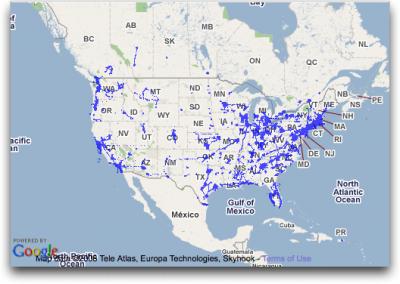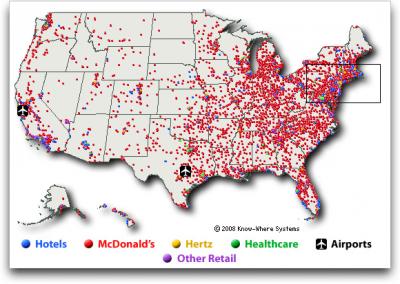The permanent URL for this article is: http://db.tidbits.com/article/9738
Include images: Off
Why I Like the Eye-Fi Explore Wireless SD Card
I fit into a category of photographer for whom the Eye-Fi Explore [1] wireless SD card is a neat fit ($129.99 at Amazon [2]). Adam Engst, our fearless publisher, has a different model - the Eye-Fi Share - that he excoriates in "Why I Hate the Eye-Fi Share Wireless SD Card [3]," 2008-08-15. Oddly, I agree with most of Adam's points, but I have found over the last several weeks that the Eye-Fi Explore works quite well for me. (I wrote a longer, more technical review [4] at Wi-Fi Networking News; you might enjoy this summary and quasi-rebuttal of Adam's thesis if you like it short and sweet.)
Explore's Extras -- The Eye-Fi Explore adds geotagging and hotspot uploads on top of features in the Share model. Its geotagging support inserts an approximate latitude and longitude into the metadata of pictures based on the Wi-Fi environment around you when the picture is snapped. Eye-Fi uses Skyhook Wireless's Wi-Fi positioning data, the same as is used for one component of the iPhone's location services, which means that it works best in cities and suburbs in industrialized countries. If you're taking photos out in the country, on the beach, or in small towns, you're unlikely to pick up a recognized Wi-Fi signal and thus a match. (You can check Skyhook Wireless's coverage online; the map shown below gives you a sense of how much of the United States they've mapped.)
I love the geotagging because it involves no effort, and puts two more dimensions onto photos, making it far easier to find and organize pictures. I'm hoping Eye-Fi figures out how to build a GPS radio into future models, or how to use an external GPS that pairs with their card.
The hotspot feature is a bit more problematic. A one-year subscription to upload at any of about 10,000 Wayport-run Wi-Fi hotspots is included in the purchase; subsequent years cost $19. Wayport powers about 9,500 McDonald's restaurants and a scattering of several hundred hotels in the United States. This is fairly thin coverage if you don't frequent fast-food franchises, but dropping in for some food-like substance and an upload isn't horribly inconvenient, given McDonald's ubiquity.
(Oddly, even though we perceive McDonald's is everywhere, they're spread rather thin in Seattle, with the nearest one to my house about a 10- to 15-minute drive away; Adam's in the same boat. McDonald's may make more sense as an upload location when you're traveling, where you would make a specific pit stop to upload pictures. Wayport has a map [6] of their McDonald's and other locations.)
The Explore has a problematic setting: if you use the Wayport uploads, the card also demands to upload to any open, login-free hotspot of any kind. I don't like that, as that behavior can get you into trouble; it should be a case-by-case and intentional choice on the user's part.
Adam's Aggravations -- Adam and I have a lot in common, but our attitudes and behavior around digital photography diverge mightily.
- Adam uses iPhoto; iDon't. I'm not a fan of iPhoto, and instead I use Microsoft Expression Media [8], which was once iView MediaPro, to organize my images without having to import them and deal with all of iPhoto's overhead and nonsense. The Eye-Fi's limitations with iPhoto don't affect me.
- Notification doesn't work for Adam because he doesn't carry a cell phone all the time, doesn't check email every few minutes, and avoids email during off hours. My home computer, a laptop, sits on top of our entertainment cabinet, which is near our Wi-Fi hub, and it's where I place the camera when it's not in use. I also generally carry a cell phone. The Eye-Fi's visual upload and notification features work best in such a situation, so I don't have the problem Adam does with forgetting to turn off the camera after it's done uploading.
- Adam finds the Eye-Fi Wi-Fi upload sufficiently slow that he stops paying attention to the camera. I see 8 megapixel photos zoom into my computer, and it only takes at most a few minutes for even dozens of photos to transfer. My camera also seems to use an extremely small amount of battery charge to keep its display active; there's no control to turn off the display after a few minutes, so, as long as the camera is on, the display is active. This is an effective reminder for me to turn it off.
- I don't mind having my "bad" pictures uploaded and transferred. Although I'd prefer to sort through and discard bad or uninteresting photos on my computer before uploading to Flickr (my choice for an online photo-sharing service), the Eye-Fi makes it much more convenient to upload everything. I have a Flickr Pro account, which puts no constraints on uploads and storage, which was a problem for Adam using his free account. True, I have to sort pictures in two locations, but since I also treat Flickr as a kind of off-site backup for photos in addition to my other forms of archiving, it's only mildly inconvenient. (I'm also not polluting the public face of my Flickr photostream with bad pictures. When I upload, I typically set privacy so that only I, or only friends and family, can view the shots; I then sort photos into more public sets, if any.)
- The lack of support in Eye-Fi for raw images doesn't bother me; my camera doesn't offer that as an option, as it's more of a snapshot model. Eye-Fi's failure to transfer movies is more troubling, because, like Adam, I have to remember to insert the card into a USB reader to transfer movies before I erase the card. This irks me, and the company could fix this very easily.
Neat, But Niche -- The Eye-Fi Explore has fit right into my consumer workflow for taking pictures. This last weekend, my wife and I threw a birthday party for my older son, Ben, who turns four today. I took pictures like crazy over a couple hours, and because we had the party at the house, most of those photos were already on my computer and up at Flickr by the time the party was over. We didn't have to swap batteries - my camera uses two AA rechargeables - and we never had to think about uploading. Now, we still have to edit and cull, and we can do that locally on our media computer (for making prints, typically) or on Flickr (for sharing with family, friends, and the world).
Future Eye-Fi models should factor in more of what Adam suggests, however, as the Eye-Fi remains a niche product, even if that niche is large, because it requires many shutterbugs change their behavior to match the card instead of having it meet their current needs.
[1]: http://www.eye.fi/products/explore/
[2]: http://www.amazon.com/dp/B001ACXHXE/?tag=tidbitselectro00
[3]: http://db.tidbits.com/article/9737
[4]: http://wifinetnews.com/archives/008418.html
[5]: http://www.tidbits.com/resources/2008-08/Skyhook-coverage-map.png
[6]: http://wayport.know-where.com/wayport/
[7]: http://www.tidbits.com/resources/2008-08/Wayport-coverage-map.png
[8]: http://www.microsoft.com/expression/products/overview.aspx?key=media

